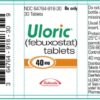“Turning responsibility on its head.”
In a (to me) stunning 9-0 decision, The US Supreme Court awarded Merck and all drug manufacturers a huge gift. Rather than finding that Merck has the responsibility for ensuring that the medical community and patients are alerted to harms their drug can cause, the Justices put the requirement on the FDA to actively demand full and accurate disclosure of devastating side effects discovered after the drug has been approved. Which would be fine if the FDA had an unending budget and masses more staff. In real life, the FDA approves on average 40+ new drugs each year and has oversight for thousands of medicines already on the market.
Fosamax Fracture Claims
Albrecht (the woman harmed with a Fosamax fracture who represented a class of more than 500 women so harmed) claims that Merck should have actively pursued disclosing to the public and the medical community that their drug Fosamax has been shown to cause spontaneous femur (upper thigh) fractures, but the US Supreme Court determined that what Merck did was enough. In short, here’s what Merck did: they submitted to the FDA documents and a request to warn of stress fractures, that is bones broken because of a fall or other stress. Stress fractures mend with a few weeks of rest. The FDA at the time rightly pointed out that so-called “Fosamax fractures” cause significantly more damage and understating them as stress fractures would mislead doctors and patients.
Then the FDA fumbled. They did not explicitly say, “come back with better wording for your label.” And that seems to be the basis of the Supreme Court decision. Which astounds me because the FDA showed by its actions that the public needed to be warned — less than two years later the FDA convened a panel about the fractures and, based on their recommendation, required Merck to change the Fosamax label to a “black box” label (the most serious warning the FDA has) to reflect the risk of spontaneous femur fractures.
When I attended the oral arguments in front of the Supreme Court, Justice Sotomayor commented (based on my notes), “Until the FDA says no, if you’re a manufacturer who understands there’s a serious risk to a drug, shouldn’t you continue to try everything possible, including making the corrections that you were told to make, including doing what the task force did, telling the FDA you’re wrong? Instead, what Merck did was say, I’m absolved, I don’t have to make the changes, I don’t have to talk to them anymore, I just have to let them — ‘them’ being the FDA — figure out what to do. Seems to be sort of turning responsibility on its head.”
As Justice Neil Gorsuch asked (again, from my notes), “Reading the statute your way, do we create a moral hazard that encourages manufacturers to supply the FDA with a lot of information, overwhelming with data, but maybe not the most artfully drafted, and maybe deliberately inartfully drafted, warning that it thinks is reasonably calculated to be refused, so that it can avoid having to shoulder or bear its own costs or internalize its own costs of negligence? What comfort can you give the Court that that’s not the outcome of the statutory regime reading that you’re proposing?”







